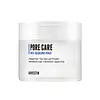What's inside
What's inside
 Key Ingredients
Key Ingredients

 Benefits
Benefits

 Ingredients Side-by-side
Ingredients Side-by-side

Water
Skin ConditioningButylene Glycol
HumectantGlycereth-26
Humectant1,2-Hexanediol
Skin ConditioningVitis Vinifera Fruit Extract
Skin ConditioningCarica Papaya Fruit Extract
Skin ConditioningPyrus Malus Fruit Extract
Skin ConditioningTerminalia Ferdinandiana Fruit Extract
AntioxidantBetula Platyphylla Japonica Juice
Skin ConditioningUlmus Davidiana Root Extract
Skin ConditioningSalvia Officinalis Leaf Extract
CleansingMelaleuca Alternifolia Leaf Extract
PerfumingMentha Citrata Leaf Extract
AstringentFicus Carica Fruit Extract
HumectantThuja Orientalis Leaf Extract
AntioxidantPhormium Tenax Leaf Powder
EmollientCharcoal Extract
Skin ConditioningPanthenol
Skin ConditioningHydroxyethyl Urea
HumectantCitric Acid
BufferingAllantoin
Skin ConditioningBetaine
HumectantEthylhexylglycerin
Skin ConditioningXanthan Gum
EmulsifyingOctyldodeceth-16
EmulsifyingDisodium EDTA
Sodium Citrate
BufferingWater, Butylene Glycol, Glycereth-26, 1,2-Hexanediol, Vitis Vinifera Fruit Extract, Carica Papaya Fruit Extract, Pyrus Malus Fruit Extract, Terminalia Ferdinandiana Fruit Extract, Betula Platyphylla Japonica Juice, Ulmus Davidiana Root Extract, Salvia Officinalis Leaf Extract, Melaleuca Alternifolia Leaf Extract, Mentha Citrata Leaf Extract, Ficus Carica Fruit Extract, Thuja Orientalis Leaf Extract, Phormium Tenax Leaf Powder, Charcoal Extract, Panthenol, Hydroxyethyl Urea, Citric Acid, Allantoin, Betaine, Ethylhexylglycerin, Xanthan Gum, Octyldodeceth-16, Disodium EDTA, Sodium Citrate
Oryza Sativa Extract
AbsorbentWater
Skin ConditioningGlycerin
HumectantDipropylene Glycol
HumectantNiacinamide
SmoothingVigna Radiata Seed Extract
Skin ConditioningSesamum Indicum Seed Extract
Skin ConditioningGlycine Soja Seed Extract
Skin ConditioningCoix Lacryma-Jobi Ma-Yuen Seed Extract
Skin ConditioningAlpha-Arbutin
AntioxidantXanthan Gum
EmulsifyingSodium Citrate
BufferingCitric Acid
BufferingDisodium EDTA
Butylene Glycol
HumectantHydroxyacetophenone
AntioxidantOryza Sativa Extract, Water, Glycerin, Dipropylene Glycol, Niacinamide, Vigna Radiata Seed Extract, Sesamum Indicum Seed Extract, Glycine Soja Seed Extract, Coix Lacryma-Jobi Ma-Yuen Seed Extract, Alpha-Arbutin, Xanthan Gum, Sodium Citrate, Citric Acid, Disodium EDTA, Butylene Glycol, Hydroxyacetophenone
 Reviews
Reviews

Ingredients Explained
These ingredients are found in both products.
Ingredients higher up in an ingredient list are typically present in a larger amount.
Butylene Glycol (or BG) is used within cosmetic products for a few different reasons:
Overall, Butylene Glycol is a safe and well-rounded ingredient that works well with other ingredients.
Though this ingredient works well with most skin types, some people with sensitive skin may experience a reaction such as allergic rashes, closed comedones, or itchiness.
Learn more about Butylene GlycolCitric Acid is an alpha hydroxy acid (AHA) naturally found in citrus fruits like oranges, lemons, and limes.
Like other AHAs, citric acid can exfoliate skin by breaking down the bonds that hold dead skin cells together. This helps reveal smoother and brighter skin underneath.
However, this exfoliating effect only happens at high concentrations (20%) which can be hard to find in cosmetic products.
Due to this, citric acid is usually included in small amounts as a pH adjuster. This helps keep products slightly more acidic and compatible with skin's natural pH.
In skincare formulas, citric acid can:
While it can provide some skin benefits, research shows lactic acid and glycolic acid are generally more effective and less irritating exfoliants.
Most citric acid used in skincare today is made by fermenting sugars (usually from molasses). This synthetic version is identical to the natural citrus form but easier to stabilize and use in formulations.
Read more about some other popular AHA's here:
Learn more about Citric AcidDisodium EDTA plays a role in making products more stable by aiding other preservatives.
It is a chelating agent, meaning it neutralizes metal ions that may be found in a product.
Disodium EDTA is a salt of edetic acid and is found to be safe in cosmetic ingredients.
Learn more about Disodium EDTASodium Citrate is the sodium salts of citric acid. In skincare, it is used to alter pH levels and acts as a preservative.
Its main functions are to maintain the pH of a product and neutralize metal ions.
The acidity of our skin is maintained by our glands and skin biome; normal pH level of skin is slightly acidic (~4.75-5.5).
Being slightly acidic allows our skin to create an "acid mantle". This acid mantle is a thin barrier that protects our skin from bacteria and contaminants.
Learn more about Sodium CitrateWater. It's the most common cosmetic ingredient of all. You'll usually see it at the top of ingredient lists, meaning that it makes up the largest part of the product.
So why is it so popular? Water most often acts as a solvent - this means that it helps dissolve other ingredients into the formulation.
You'll also recognize water as that liquid we all need to stay alive. If you see this, drink a glass of water. Stay hydrated!
Learn more about WaterXanthan gum is used as a stabilizer and thickener within cosmetic products. It helps give products a sticky, thick feeling - preventing them from being too runny.
On the technical side of things, xanthan gum is a polysaccharide - a combination consisting of multiple sugar molecules bonded together.
Xanthan gum is a pretty common and great ingredient. It is a natural, non-toxic, non-irritating ingredient that is also commonly used in food products.
Learn more about Xanthan Gum